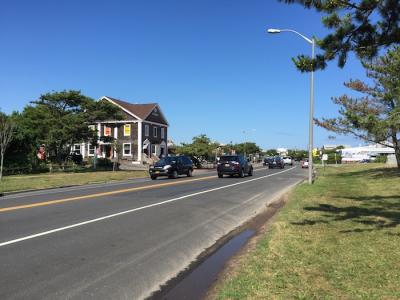Sewage Treatment for Downtown Montauk?

With the collective conviction that the time to act is now, the East Hampton Town Board engaged on Tuesday in a long discussion about the creation of a wastewater treatment system for downtown Montauk, and a tax district to help fund it.
Meeting in the easternmost hamlet’s firehouse, the board listened as Joanne Pilgrim, executive assistant to Supervisor Peter Van Scoyoc, reviewed its past discussions and engagement with Lombardo Associates, a consulting firm, to create a plan for a centralized wastewater treatment plant. The discussion, she said, has grown to include interrelated issues such as sand replenishment along downtown Montauk’s ocean shoreline and a longer-term strategic retreat from rising sea level.
“Particularly,” Ms. Pilgrim said, “some property owners” and managers of the oceanfront motels “want to know, if they’re going to become participants in wastewater treatment, if they will have a business plan for the foreseeable future for a healthy beach.” The discussion is in tandem with another, about creating a beach replenishment tax district, she said.
Improving the downtown’s wastewater treatment is urgent in order to limit the release of pollutants that could impact ground and surface waters, including Fort Pond, which has suffered from harmful algal blooms. The hamlet’s citizens advisory committee has asked for a wastewater district, Mr. Van Scoyoc said.
Many of the hamlet’s commercial properties have septic systems that are defined as nonfunctioning, a designation assigned a system that must be pumped out more than four times per year. But a large majority of downtown properties do not have room to replace a failing system with a state-of-the-art, low-nitrogen septic system, as their buildings occupy most of the lots.
The federal Environmental Protection Agency banned new large-capacity cesspools in 2000 because untreated sanitary waste from cesspools can enter groundwater and contaminate drinking-water sources. A ban on existing large-capacity cesspools went into effect in 2005. “Those regulations could potentially put downtown property owners in a tough spot,” Ms. Pilgrim said. “A community system would offer a solution and a way to resolve” environmental impacts on ground and surface waters related to septic waste.
The location of a treatment site has not been determined, though a property near the recycling center on Montauk Highway has been considered. Additional high-density areas could be tied into the system later, adding to its cost.
Securing grant funding will be important to accomplishing the goal, the town having set a target of 75 percent of the approximately $32 million price tag. Should the town move forward with a wastewater district, it would hope to receive grant money from the state Environmental Facilities Corporation, Ms. Pilgrim said. That grant application has an expected submission deadline of the end of July. The community preservation fund, up to 20 percent of which voters decided in 2016 could be allocated to water quality improvement projects, could also be tapped.
Should the town move forward, Lombardo Associates would have to prepare a mapping plan, Ms. Pilgrim said.
A formal proposal could be put to a public vote, for which the district’s registered voters would be eligible, or the board could adopt the creation of a tax district, which would then be subject to a permissive referendum. In the latter course, a public vote would be forced should someone object and file the signatures of 5 percent of the total vote cast in the last gubernatorial election with the town clerk within 30 days.
“We have a very densely populated business district,” Mr. Van Scoyoc said, with “businesses that regularly pump out” their septic systems, in some cases almost daily. “We’re a beachfront community, our water quality is important. . . . This is an issue that has to be dealt with, and now.”
It is important, Mr. Van Scoyoc said, that property owners understand why a wastewater district is important and that the board “take a hard look at costs” and how to reduce them through grant funding. “I believe this is the least expensive time to make this move,” he said. “We don’t have the luxury of waiting.”
A public hearing on creation of a wastewater district will be necessary, he said, likening the process to the board’s recent move to create a water supply district in Wainscott so that the Suffolk County Water Authority can extend mains and connect properties that rely on well water, in the wake of the discovery that many wells there are contaminated with perfluorinated compounds. “Our efforts should be focused on creating a district as soon as we can,” he said. “There has to be public outreach, communication — that has to happen first. We need to put together very specific outreach to property owners, stakeholders within the district, to engage them and the community as to why this needs to be done, what it is we’re looking to do, and when.”
With respect to a strategic retreat from the shore, “it’s really all about timing,” the supervisor said, adding that the likelihood of a major hurricane increases every year. “Trying to make this transition with the least amount of disruption, maintaining the greatest amount of viability . . . so it’s not disruptive and we’re not having this conversation in an emotionally heightened state post-major hurricane,” he said, is “a very difficult choreography to undertake.”
